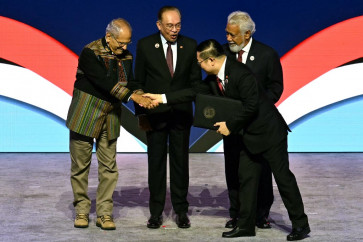Popular Reads
Top Results
Can't find what you're looking for?
View all search resultsPopular Reads
Top Results
Can't find what you're looking for?
View all search resultsDelays may hit several geothermal projects
State electricity company PT PLN has predicted that as of 2014, only 1,200 megawatts (MW) of electricity will be produced by geothermal power plants, lower than the target of the second phase of the 10,000 MW fast-track program of 3,970 MW
Change text size
Gift Premium Articles
to Anyone
S
tate electricity company PT PLN has predicted that as of 2014, only 1,200 megawatts (MW) of electricity will be produced by geothermal power plants, lower than the target of the second phase of the 10,000 MW fast-track program of 3,970 MW.
PLN’s president director Dahlan Iskan said Friday that many geothermal power plant projects may not be completed on schedule because to date, private investors are still reluctant to go ahead with their exploration activities.
“The risk is too high. It costs around Rp 75 billion [US$8.34 million] to drill one exploration well, the results of which are still uncertain,” he said.
To solve the problem, Dahlan has proposed that the House of Representatives’ Commissions VI and VII (overseeing state-owned companies, and energy, respectively), allow the company to use Rp 1.2 trillion of revolving funds, allocated by the Finance Ministry, for geothermal development.
“Our first proposal is that the Finance Ministry gives us Rp 375 billion to fund five drillings carried out by private investors. If they find the steam, they would have to pay back the money plus interest, but if they fail, the money is lost, and the government takes the risk,” he explained.
The second option, Dahlan continued, is that the funds could be given to the Energy and Mineral Resources Ministry to conduct early drilling at a cost of Rp 25 billion per well to collect more data about the potential of a geothermal working area. He added that way, the risk for private investors could be reduced.
“The last option is that the government could allocate [portions of] the funds to regional governments that oversee geothermal areas, and they carry out the drillings. With better data collection, the tender process would be more competitive,” he suggested.
Besides geothermal energy, Dahlan also reported that several transmission lines in the first phase of the 10,000 MW fast-track program had not been completed, such as from the Lontar coal-fired power plant in Banten to the New Tangerang powerhouse, due to problems with land acquisition.
He claimed that if the transmission line were installed, the electricity produced at the power plant could substitute the electricity produced by the Muara Karang power plant in North Jakarta which, due to gas shortages, had to burn oil-based fuels to generate power.
“If we can reduce the usage of oil-based fuel at the Muara Karang power plant, we can save up to Rp 3 trillion a year,” he revealed. According to the company’s data, the Lontar power plant has a total capacity of 3x315 MW.










